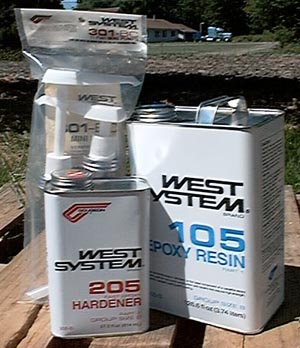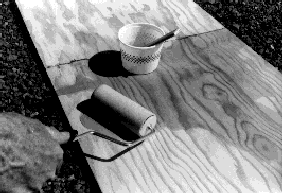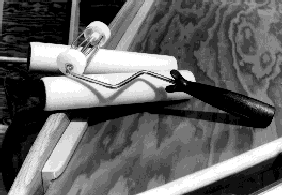Boat Kits:
Boats:
New Ebay Items
Things You'll Need to Complete the Boat:
Further Items You May Want to Add:
Tools You Will Need To Assemble A Boat Kit
Articles:
What comes with a driftboat kit?
What comes with a rowboat kit?
Greg's Online Water Color Gallery
Can I Do It (what skills you need)
How To Order
Other Topics:
West System Epoxy
|
Marine epoxy, led by the Gougeon Brothers WEST SYSTEM brand
marine epoxy products, has revolutionized the making of wooden
boats. Wood, as a material for boats has lost a lot of favor over
the years, as a result of the aging of the wooden boat "fleet" and
the advent of fiberglass and aluminum for use in boat construction.
Now the early boats built with glass are oxidizing and
de-laminating, and the shiny aluminum boats are now showing their
dents and loose rivets or welds. At the same time, epoxy has come of
age as a superior marine glue, a filler, and a coating which greatly
inhibits dry rot in wood. Now, wood boats can be built with a wide
variety of construction techniques using epoxy, making excellent
crafts on par or even better than boats made with glass or
aluminum.  We sometimes use epoxy as a coating on the plywood sides and
bottom before the boat is assembled. We use marine grade Douglas fir
plywood as a standard plywood on all our kits. Fir plywood is an
excellent material to build boats. The long fiber structure and
lightness, as well as its relative resistance to dry rot makes for
beautiful, long lasting enjoyment. It holds a place in our hearts as
well because it is a wood that is native to Oregon. (There are few
things as pretty as a fir colored, naturally finished drift boat
floating in space over a crystal clear, but slightly green stretch
of the Mckenzie River on a hot July afternoon!) One characteristic
of fir plywood is that is can be subject to checking - small hairline
cracks along the grain - when boats (that have a natural finish)
aren't able to be stored inside. Coating with epoxy seems to greatly
inhibit this, as it is able to saturate deeply into the wood to help
"glue" the fibers together. In extreme use, boats (sides and bottoms
prior to assembly) can even be sheathed with a very light fiberglass
cloth in order to stabilize the grain. This amounts to a lot of
effort, extra expense and weight. Our opinion is that the addition
of cloth is worth it only in extreme cases. |
||||||||||||||||||||||||||||
|
|
||||||||||||||||||||||||||||
Applying Epoxy How is epoxy applied as a coating? We recommend applying it on the plywood sides and the bottom prior to assembly of the boat. First we mix it up in a flexible container, such as a margarine container. We pump the container almost full, then mix it very thoroughly. We then immediately pour it out on the surface, so that the heat it creates while curing can dissipate, which gives it a much longer pot life. We further spread it around with a board of some sort, then roll it smooth with a foam roller, using slow strokes, minimizing bubbling. Do not apply in the direct sun, as heated air will bubble out of the plywood, causing bubbles and craters. Curing time depends on the temperature of the workspace, but it is normal to cure overnight, then re-coat the next day. Two coats usually does the trick. After curing, there is a greasy film (a so-called "amine blush") on the surface of the epoxy. This film must be removed by wetsanding with #220 sandpaper (do it by hand and scrub like you're cleaning a dirty pan). Only then can whatever is to go over the epoxy be applied. It is worth noting, though, that if a second coat of epoxy is to be applied one can forego the previous step by applying the second coat before the first has fully cured: Apply the first coat, let it become firm, but before it ceases to be tacky spread out the second coat. In any case, the final cured coat will need to be sanded before the application of any other coatings (e.g., varnish or paint). A couple of tricks we use to ease application: First, we sand the plywood with a fine grit (#220) right before coating with epoxy, in order to reduce the raised grain and help minimize the sanding of the epoxy after it hardens. We clean the surface with a vacuum cleaner with a brush attachment before applying the epoxy. We also use a fairly generous amount of epoxy so that it will flow out more easily and to help minimize the roughness common on a first coat. Epoxy should only be applied to bare wood. If a
stain is desired, use only a water-based dye stain and allow it to
fully dry before proceeding with the epoxy. The object is to
allow the epoxy to bond with the fibers of the wood unimpeded,
strengthening both the bond of the coating and the structure of the
wood. If you desire to use a more common oil based stain for the
sides and bottom - a very popular choice on Fir - you should use
only varnish over the stain, not coat with epoxy. |
or e-mail at mckenzie@gregboats.com

